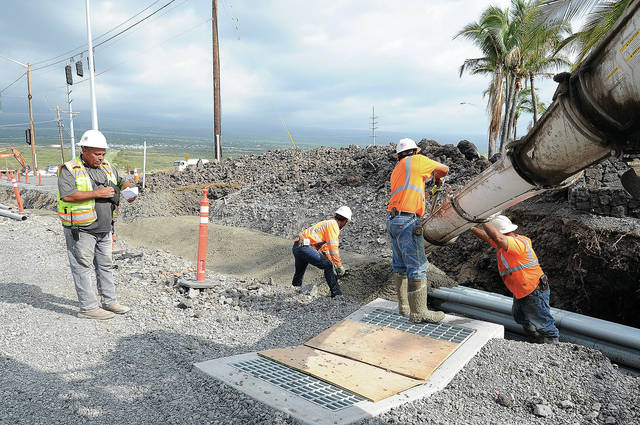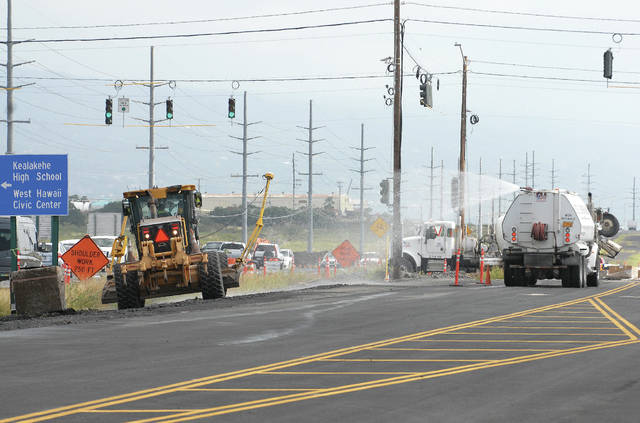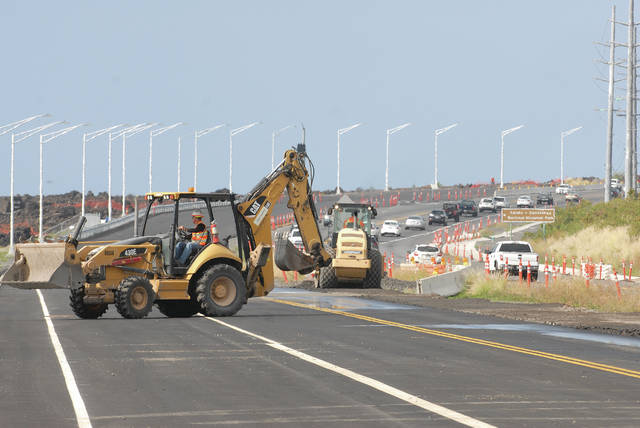KAILUA-KONA — It’s going to cost another $16.3 million to widen Queen Kaahumanu Highway from Kealakehe Parkway to Keahole Airport Road, compared to numbers released earlier this year, putting the project more than $30 million over initial estimates from its groundbreaking two years ago.
The project, once complete, will widen a little more than 5 miles of Highway 19 from two to four lanes while also putting in new lights and signals.
The first phase of the project widened the road from Henry Street to Kealakehe Parkway, a roughly 2.6-mile stretch of road.
Shelly Kunishige of the Hawaii Department of Transportation’s public affairs office said the additional $16 million would be paid to the contractor, Goodfellow Bros. Inc., “to keep the crews working on the Queen Kaahumanu Highway Widening Phase 2 and to account for increased work needed to significantly complete the project by August 2018.”
That money may affect the availability of funds for future projects, she said, but she also added that they aren’t anticipating significant additional costs.
“(The department) continues to prioritize safety and system preservation projects on all islands and will take the benefits of all projects into account for programming purposes,” she said.
The Hawaii Department of Transportation broke ground on phase two of the project in September 2015. At that time, the cost was estimated at $90 million. But even by then, that number was well over the $76 million contract awarded in 2010.
The new cost, now pegged at $121.3 million, reflects the “approximate current contract amount,” according to a Hawaii DOT website that publishes data and status reports for all current state highway projects.
The entire $121-million cost is not being paid to the contractor, Kunishige said.
Ed Brown, Hawaii vice president of operations for Goodfellow Bros. Inc., said its contract is probably around $110 million at the moment.
Many of the modifications to the contract were made to ensure the protection of historical sites, particularly in the stretch near Kaloko-Honokohau National Historical Park. About a mile and a half of the highway runs adjacent to the park’s mauka boundary.
There haven’t been many new issues with the project. Brown said that in the past, because of the park and archaeological issues, the decision was made to shrink the median to protect archaeological sites and give the park more of a buffer.
But shrinking the median isn’t as easy as just shifting the pavement; it also meant a redesign and moving the water and sewer lines.
Shrinking the median also involved other modifications, he added. Because of the area’s terrain and the slope of the land, they had to put in large retaining walls. Walls will also go around archaeological sites to create a buffer, and then the road has to be built outside of the buffer.
At the same time, shrinking the median also brought the traffic traveling in opposite directions too close together, he said. That and the road’s design meant they had to put in a concrete median.
“So that was another effect of shrinking the median down,” he said.
Crews are also putting in three concrete swales or channels – one each on the mauka side, makai side and the middle – and a series of dry wells on the makai side to protect anchialine ponds from any potentially contaminated runoff from the road.
All of that is material costs and labor costs that add up and weren’t in the original bid proposal.
“There’s things you can’t anticipate,” said Brown. “There’s just no way. You can’t anticipate everything.”
So when they run into an issue, he said, it’s a matter of evaluating it, figuring a cost and sitting down with the state to come up with a number.
“And that takes months of negotiation,” he added.
Doug Hecox, spokesperson for the Federal Highway Administration (FHWA), said cost increases aren’t out of the ordinary for highway projects and contract modifications involving archaeological sites can be hard to anticipate.
“They happen, and nobody really likes that they happen,” he said, “but they do.”
The agency is funding 80 percent of the project. As costs have grown, the project has and will continue to be an 80-20 cost share, Hecox said, with the feds picking up the larger portion, as long as the work is eligible for federal funds.
Hecox added that they’re keeping an eye on proposed changes to the contract as they come in.
“We’re looking at each and every one of the contract modifications before they’re approved,” he said.
Sen. Josh Green (D-Kona, Ka‘u), who has been a vocal supporter of the widening project over the years said that while the project is a top priority for the area, he said he’s “never pleased to see cost over-runs.”
“Every time a big project comes up, we need to do it as affordably as possible,” he said.
The DOT website indicates the project is 84 percent complete — up from 60 percent at the end of July — and is still expected to be substantially completed by August.
“Everything is moving very smoothly,” Brown said.
“We’re all in the same direction to hit that deadline,” he added. “We’re all pulling together to hit that deadline, which is great.”










